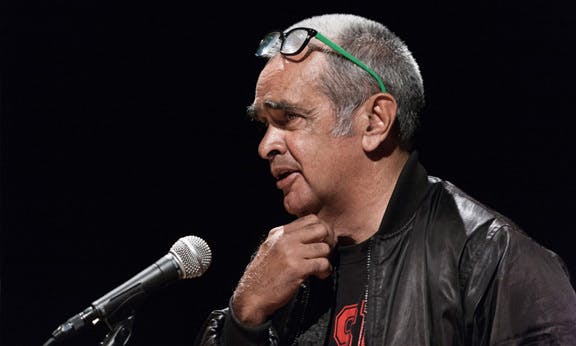Gary Foley: ‘a direct and fiercely intellectual man’

A close friend of mine, Chris Healy, a cultural studies scholar at the University of Melbourne, recently made the observation that Gary Foley is one of the few true radicals of this country’s modern history.
The Australia Council in May last year recognised Foley with the Red Ochre Award, which acknowledges lifetime achievement in Aboriginal and Torres Strait Islander arts at a national and international level.
It’s true that Foley is a radical. While some activists of the protest era of the 1960s chose to burn out, rather than fade away, others grew fat and powerful, forgot about Marx, and grasped hold of any post critique that would absolve them of their traitorous sins.
Some of the same people now administer the institutional cogs of the state, including universities, where we suffer “compliance”, metrics of all persuasions, and occasional bureaucratic humiliation.
Foley himself works in an institutional setting, at Victoria University in Melbourne’s western suburbs. The campus is devoid of both sandstone and elm trees. I gave a guest lecture at the St Albans campus in 2014 and saw a large rat saunter by the canteen, in no hurry to scamper off. I enjoyed the rodent’s bold attitude.
It’s not surprising that an intellectual such as Foley thrives in such an environment. He has never been one for window-dressing, status or bullshit. He is a direct and fiercely intellectual man, driven by a lifelong project of sharpening his own intellect, realising the political force behind ideas and sharing them with others.
Those who do not know Foley, as either an educator or friend, make the error of casting him out as an outsider and separatist. Nothing could be further from the truth.
As a teacher, he is stimulating, challenging and generous. He has taught literally thousands of students over the years, many of them young non-Aboriginal people. While some students are initially hesitant upon first meeting him, they are soon surprised by the level of patience and guidance he conveys in a classroom setting.
As a public intellectual he is a more complicated figure. He was known as a firebrand in his younger days, and although he often stresses the extent to which he has mellowed in “old age” (using a walking stick as a deceptive prop), he can still hit a high register when the political need arises.
But he is neither an ideologue nor a polemicist. His political activism has been historically informed by intellectuals of the left, both black and white, in addition, importantly, to popular culture. Even so, he has never followed any party line, has always set the highest intellectual standard for himself, and is the first to question his own thinking.
A grassroots intellectual
While some Aboriginal people on the national political stage either claim to represent our diverse communities, or present themselves as leaders in all but name, Foley is a highly respected grassroots intellectual. Most of our people live in a state of powerlessness and rely deeply on representatives such as Foley to facilitate a voice for the voiceless.
After the election of the Kennett conservative government in Victoria in 1992 both public institutions and individuals came under attack from the economic rationalist policies dominating government policy. State schools across Victoria came under threat.
One of those schools was Northlands Secondary College, located in the heavily working-class and multi-ethnic northern suburbs of Melbourne. It was a school with a relatively high enrolment of Koori (Aboriginal) students, although it was not, as many people claim, “an Aboriginal school”.
Foley and others were centrally involved in a public campaign and legal battle to keep the school open. They succeeded where so many had failed.
On the day following the court decision I was at the Aboriginal Health Service in Nicholson Street, Melbourne – an organisation Foley played a major role in establishing. I could hear a rowdy conversation taking place amongst the “smokers”, a group of Elders who gathered out the back for a smoke.
A chorus rang out amongst the coughing and spluttering.
“He stuck it up them!”, one of the Elders sang.
“Yeah! Foley stuck it up them!”, the chorus replied.
This group of largely older and frail Koori people are amongst the most disenfranchised in Australian society. Foley has always stood up for such people. He has done so with what some might consider a great cost to individual success. I have no doubt Foley would disagree.